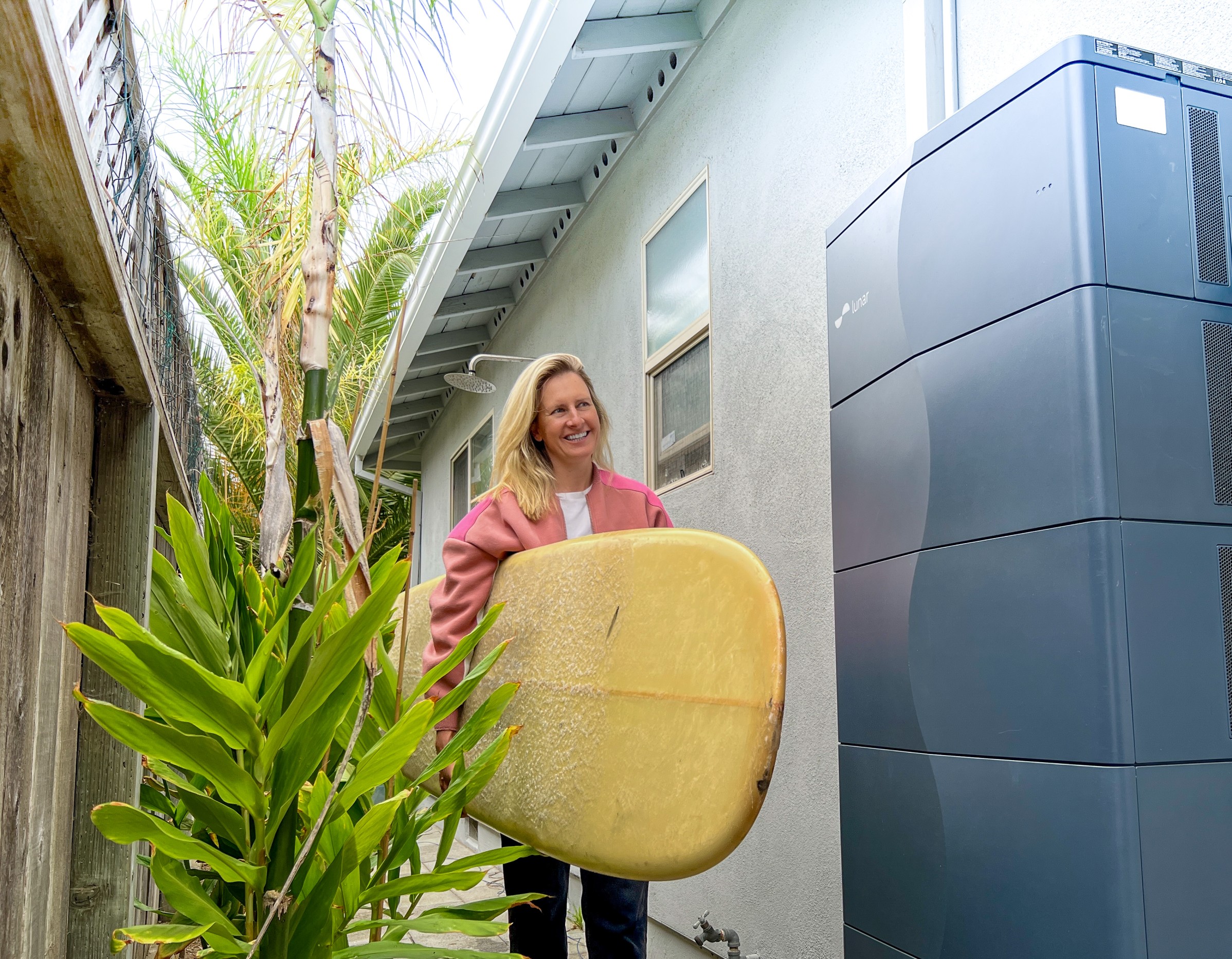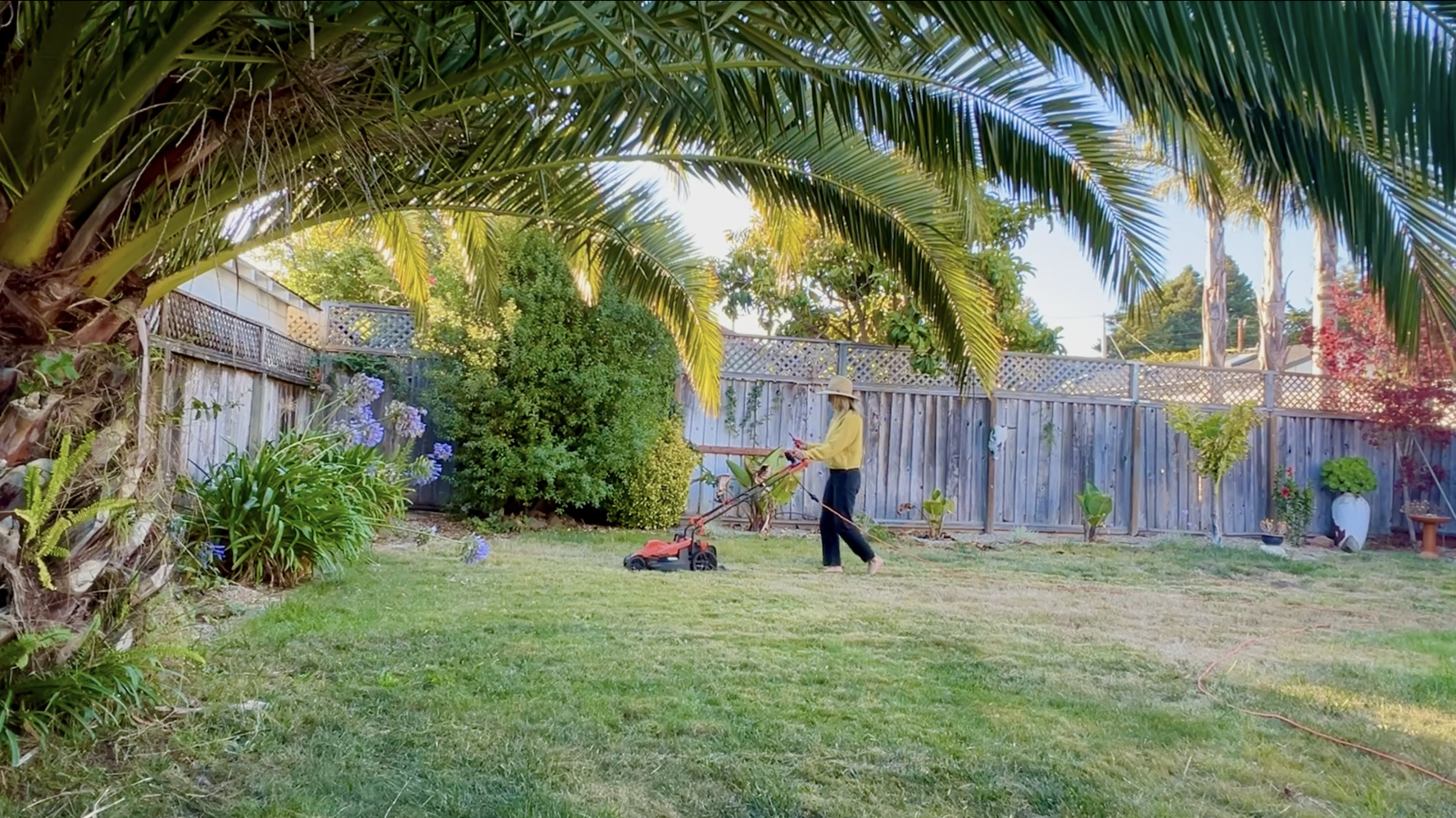Design your Lunar System
Save money, make money, avoid grid outages, and power your life with clean energy day and night.

Marissa lives in a small beach bungalow. Her mornings often start in the waves, her evenings bathed in light she captured hours earlier. She bottles the sun by day to power her home by night, a balance of nature and independence she’s always chased.
Marissa didn’t set out to become her own personal power plant. She just wanted a car that wouldn’t break down on the freeway.
One morning, the oil light in her gas car blinked on—again. She brought it to the mechanic expecting a quick fix, only to hear:
“If you keep driving, your engine could fall out.”
The repairs would cost as much as the car was worth. She could have fixed it, but she knew pouring more money into gas wasn’t the future she wanted.
“That was the moment I decided, I’m going electric. I built a quick model to evaluate the cost of switching over from gas to electric, and the economics just made sense.” Marissa said.
She bought a used EV and realized: charging it with dirty grid power defeated the purpose. If she wanted true energy independence, she needed solar and a battery at home.
“It wasn’t just about going green,” she says. “It was about taking ownership of my energy, where it comes from, how it’s used, and who controls it.”
Soon after installing the Lunar System, a local outage hit during a summer heat wave. Marissa wasn’t worried about the lights, she was worried about the freezer. It held dozens of ounces of breast milk for her newborn daughter.
“The battery kicked in instantly. I didn’t lose power, and I didn’t lose the milk,” Marissa said. “That moment changed how I viewed the solar battery system. It wasn’t just backup anymore. It was protection. It gave me confidence, and one less thing to worry about.”
While the outage proved the system’s reliability, an afternoon mowing her lawn proved its freedom. With her battery full and solar panels still producing, Marissa realized she could use that surplus energy however she wanted, in real time. No guilt, no cost, no carbon. Just her own sunshine powering her life.
She grabbed her electric lawnmower, plugged it in, and opened the Lunar App. “Watching my mower run on sunlight, and seeing the energy flow live, was such a rush. The sun has never felt so powerful.”
Now she plans her chores around sunshine: dishes, laundry, yard work. “It’s not just about economics,” she says. “It’s joy. It’s agency. And it’s the thrill of living off your own energy.”
Charging her car off her own rooftop solar is the same: “I haven’t been to a gas station in years. Driving on your own harvested sunshine is the most liberating feeling.”

Marissa’s home is small by design, a beach bungalow on a tiny lot. “The house is just a postage stamp in a postcard setting,” she said. “I want to live close to nature, and I want to keep my footprint light.”
But gas appliances still hum in the background. They’re loud, fiery, and unhealthy.
“You can hear them roar to life, let that be my wall furnace or oven, and you can feel their impact on the air inside. I want silence. I want clean, especially now that I have young lungs in the house.”
Marissa’s mission to get gas out of her house continues. Next up: a heat pump, an electric water heater, and an induction stove.
[[callout]]
I’ve spent 15 years in clean energy, from biking across America on a solar-powered bicycle to helping all types of homeowners and businesses go solar and pair it with a battery.
Her message today, especially to women managing homes, kids, and bills, is simple:
"You don’t have to know all the tech stuff. Just find a solar installer you trust, tell them what matters most to you—backup during outages, cutting bills, driving on sunshine etc—and they’ll help you design the right system,” she said. “The key is making sure it’s an all-in-one system so it works seamlessly and gives you full transparency, confidence and control,” Marissa added.
[[/callout]]
A solar battery is a long-term investment, both in your energy future and in the company you choose. Most batteries today carry a 10-year warranty and can operate well beyond that.
The Lunar System offers one of the strongest warranties on the market:
This ensures your system will perform for decades, while also protecting your purchase. And because Lunar designs, integrates, and engineers everything, you’re not just buying a product, you’re gaining a trusted partner for the next 10+ years.
Great hardware is only half the story, the software is the other half. You want a product that includes AI-driven software that creates a custom energy plan for your home every single day.
Look for software that accounts for:
The system should use this data to optimize when to use, store, or share your energy, saving you money and maximizing your use of self-generated power.
Just as important: you should be able to see what’s happening in real-time, and if you want, override the AI to take control manually. The best systems give you both smart automation and complete transparency.
Yes. But only if you have solar panels plus a battery.
Solar alone will not power your home during an outage. Most rooftop solar systems are grid-tied, meaning they shut down for safety when the grid is off, unless they’re paired with a battery.
A properly sized battery can run your entire home. Marissa’s 20 kWh battery has powered her small home for days, and because the battery recharges each day via solar, it can power her home indefinitely.
Think about it like packing for a trip. You need to know what you’re bringing and where you’re going.
Start with a few key questions:
For reference, the average U.S. home uses about 30 kWh a day. Battery sizes range from 10 to 20+ kWh, and with Lunar you can choose from 15, 20, 25, or 30 kWh in a single sleek unit—so you save wall space and get more capacity.
But battery size isn’t the whole story. The inverter is like the system’s muscle. It converts your solar and stored battery power from DC (direct current) into AC (alternating current), which your home runs on. The inverter rating (in kW) tells you how many big appliances you can power at the same time, especially during an outage.
For example, Lunar’s inverter can deliver up to 10 kW continuously. That’s enough to run multiple large loads, like your refrigerator, lights, internet, and even an air conditioner, without tripping the system.
Pro tip: Make sure you have both enough inverter capacity and load control. Adding smart breakers to your biggest loads—like your dryer, pool pump, or air conditioner—lets the system automatically shed those loads during an outage so you don’t trip it. Lunar offers this too, so your system can keep running smoothly and extend coverage during an outage.
And here’s the big takeaway: future-proof it. If you’re going to electrify more of your home over time, it’s worth sizing up now so your system can grow with you.
DC-coupled systems connect your solar panels directly to the battery using direct current (DC). AC-coupled systems convert solar DC power to alternating current (AC) first, then back to DC to store in the battery—and again to AC to use in your home.
Every conversion loses energy. That’s why DC-coupled systems are more efficient. They avoid double conversion and preserve more of your solar power for use or storage. So if you’re getting new solar and a battery, choose the DC-coupled product.
Lunar’s system is DC-coupled, which means: